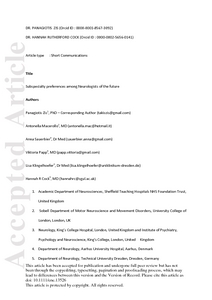Zis, P; Macerollo, A; Sauerbier, A; Papp, V; Klingelhoefer, L; Cock, HR
(2018)
Subspecialty preferences among Neurologists of the future.
Eur J Neurol, 25 (3).
pp. 597-601.
ISSN 1468-1331
https://doi.org/10.1111/ene.13526
SGUL Authors: Cock, Hannah Rutherford
![[img]](https://openaccess.sgul.ac.uk/109360/1.hassmallThumbnailVersion/Zis_et_al-2017-European_Journal_of_Neurology.pdf)  Preview |
|
PDF
Accepted Version
Available under License ["licenses_description_publisher" not defined].
Download (735kB)
| Preview
|
Abstract
INTRODUCTION: In the era of neurological subspecialization, most neurologists will have a field of specialist interest. The aim of this cross-sectional multi-national study was to identify the key areas of interest among trainees or junior specialists, assess the potential influence of an interest in research, and consider the results in light of population needs. METHODS: A total of 300 residents and junior neurologists who received a bursary to attend the European Academy of Neurology conference were invited to participate in this study. Demographic and work-related characteristics, as well as main subspecialty of choice were examined via an anonymous electronic questionnaire. Participants holding a higher degree (PhD/MD) or working in research posts were considered research oriented. RESULTS: In total, 191 Neurologists in training or junior specialists responded (response rate 63.7%). Full data were available for 187 participants (59.4% females). The study sample had a mean age of 30.5±3.4 years (range 25 - 45). The most popular subspecialty was movement disorders (18.2%), followed by multiple sclerosis (11.2%) and epilepsy (10.2%). This did not differ significantly between the participants who were or were not research-oriented. CONCLUSIONS: There is a potential mismatch between the interests of trainees, and the future needs of the populations they serve, which it is important to identify for workforce planning.
| Item Type: |
Article
|
| Additional Information: |
This is the peer reviewed version of the following article: Zis, P., Macerollo, A., Sauerbier, A., Papp, V., Klingelhoefer, L. and Cock, H. R. (2018), Subspecialty preferences among neurologists of the future. Eur J Neurol, 25: 597–601., which has been published in final form at http:doi.org/10.1111/ene.13526. This article may be used for non-commercial purposes in accordance with Wiley Terms and Conditions for Self-Archiving. |
| Keywords: |
Neurology training, education, subspecialty, Neurology & Neurosurgery, 1103 Clinical Sciences, 1109 Neurosciences |
| SGUL Research Institute / Research Centre: |
Academic Structure > Institute of Medical & Biomedical Education (IMBE) |
| Journal or Publication Title: |
Eur J Neurol |
| ISSN: |
1468-1331 |
| Language: |
eng |
| Dates: |
| Date | Event |
|---|
| 21 February 2018 | Published | | 18 December 2017 | Published Online | | 28 November 2017 | Published Online | | 20 November 2017 | Accepted |
|
| Publisher License: |
Publisher's own licence |
| Projects: |
|
| PubMed ID: |
29193501 |
 |
Go to PubMed abstract |
| URI: |
https://openaccess.sgul.ac.uk/id/eprint/109360 |
| Publisher's version: |
https://doi.org/10.1111/ene.13526 |
Statistics
Item downloaded times since 14 Dec 2017.
Actions (login required)
 |
Edit Item |



